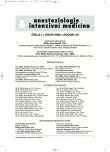Dosage and administration of antibiotics in critically ill patients
Authors:
Chytra Ivan; Štěpán Martin
Authors‘ workplace:
Anesteziologicko-resuscitační klinika LF UK a Fakultní nemocnice v Plzni
Published in:
Anest. intenziv. Med., 20, 2009, č. 1, s. 25-29
Category:
Intesive Care Medicine - Review Article
Overview
Early and appropriate antibacterial therapy is a principal intervention in septic patients. Adequate fluid resuscitation in the hyperdynamic stage of sepsis increases renal perfusion and via increased capillary permeability leads to a leak into the third space. The increased clearance and volume of distribution may result in low plasmatic concentration of antimicrobial drugs. Alternatively, sepsis can induce multiple organ dysfunction (kidney, liver), causing a decrease of antimicrobial drug clearance with increased risk of toxic effects.
To optimize antibacterial therapy, clinician must know the properties of the used antibiotics and how these may be affected by the pathophysiological changes occurring during sepsis.
Keywords:
antimicrobial therapy – sepsis – pathophysiological changes – pharmacokinetic and pharmacodynamic parameters – dosage of antibiotics
Sources
1. Dellinger, R. P., Levy, M. M., Carlet, J. M. et al. Surviving Sepsis Campaign: international guidelines for management of severe sepsis and septic shock: 2008. Intensive Care Med., 2008, 34, p. 17–60.
2. Lipman, J. et al. Ciprofloxacin pharmacokinetic profiles in paediatric sepsis: how much ciprofloxacin is enough? Intensive Care Med., 2002, 28, p. 493–500.
3. Lipman, J. et al. Low cefpirome levels during twice daily dosing in critically ill septic patients: pharmacokinetic modelling calls for more frequent dosing. Intensive Care Med., 2001, 27, p. 363–370.
4. Pinder, M., Bellomo, R., Lipman. J. Pharmacological principles of antibiotic prescription in the critically ill. Anaesth. Intensive Care, 2002, 30, p. 134–144.
5. Pea, F. Pharmacokinetic considerations for antimicrobial therapy in patients receiving renal replacement therapy. Clin. Pharmacokinet., 2007, 46, p. 997–1038.
6. Fisman, D. N., Kaye, K. M. Once daily dosing of aminoglycoside antibiotics. Infect. Dis. Clin. North. Am., 2000, 14, p. 475–487.
7. Munckhof, W. J., Grayson, M. L., Turnidge, J. D. A meta-analysis of studies on the safety and efficacy of aminoglycosides given either once daily or as divided doses. J. Antimicrob. Chemother., 1996, 37, p. 645–663.
8. Freeman, C. D., Nicolau, D. P., Belliveau, P. P. Once-daily dosing of aminoglycosides: review and recommendations for clinical practice. J. Antimicrob. Chemother., 1997, 39, p. 677–686.
9. Olsen, K. M., Rudis, M. I., Rebuck, J. A. et al. Effect of once-daily dosing vs. multiple daily dosing of tobramycin on enzyme markers of nephrotoxicity. Crit. Care Med., 2004, 32, p. 1678–1682.
10. Angus, B. J. et al. Pharmacokinetic-pharmacodynamic evaluation of ceftazidime continuous infusion vs intermittent bolus injection in septicaemic melioidosis. Br. J. Clin. Pharmacol., 2000, 50, p. 184–191.
11. Krueger, W. A. et al. Influence of combined intravenous and topical antibiotic prophylaxis on the incidence of infections, organ dysfunctions, and mortality in critically ill surgical patients: a prospective, stratified, randomized, double-blind, placebo-controlled clinical trial. Am. J. Respir. Crit. Care Med., 2002, 15, p. 1029–1037.
12. Jaruratanasirikul, S. et al. Comparison of the pharmacodynamics of meropenem in patients with ventilator-associated pneumonia following administration by 3-hour infusion or bolus injection. Antimicrob. Agents Chemother., 2005, 49, p. 1337–1339.
13. Lorente, L. et al. Meropenem by continuous versus intermittent infusion in ventilator-associated pneumonia due to gram-negative bacilli. Ann. Pharmacother., 2006, 40, p. 219–223.
14. Chytra, I. et al. Clinical efficacy of continuous versus intermittent administration of meropenem. Intensive Care Med., 2006, 32, Suppl. 1, p. 9.
15. Rello, J. et al. Pneumonia caused by oxacillin-resistant Staphylococcus aureus treated with glycopeptides. Crit. Care Med., 2005, 33, p. 1983–1987.
16. Wysocki, M., Delatour, F., Faurisson, F. et al. Continuous versus intermittent infusion of vancomycin in severe Staphylococcal infections: prospective multicenter randomized study. Antimicrob. Agents Chemother., 2001, 45, p. 2460–2467.
Labels
Anaesthesiology, Resuscitation and Inten Intensive Care MedicineArticle was published in
Anaesthesiology and Intensive Care Medicine

2009 Issue 1
Most read in this issue
- Dosage and administration of antibiotics in critically ill patients
- Robot-assisted laparoscopic surgery from the anaesthesiologist’s perspective
- The importance of tidal volume and its monitoring during high-frequency ventilation
- Guidelines for the treatment of invasive candidiasis
